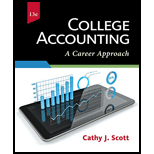
Concept explainers
Journalize the difference between cash count and cash reported on cash register.
Explanation of Solution
Debit and credit rules:
- Debit an increase in asset account, increase in expense account, decrease in liability account, and decrease in
stockholders’ equity accounts. - Credit decrease in asset account, increase in revenue account, increase in liability account, and increase in stockholders’ equity accounts.
Journalize the difference between cash count and cash reported on cash register.
Transaction on July 28:
| Date | Account Titles and Explanations | Post. Ref. | Debit ($) | Credit ($) | ||
| July | 28 | Cash | 893.50 | |||
| Cash Short and Over | 1.70 | |||||
| Income from Services | 895.20 | |||||
| (Record cash shortage in the revenue earned) | ||||||
Table (1)
Description:
- Cash is asset account. Since the cash collected from sales revenue is recorded, the asset value increased. So, debit the cash account with $893.50.
- Cash Short and Over is an income statement (expense or revenue) account. The increase (overage) is credited and recorded as Revenue, and decrease (shortage) is debited and recorded as Expense. Hence, debit Cash Short and Over account with $1.70 indicating an expense.
- Income from Services is a revenue account. Revenues increase the stockholders’ equity value. So, credit Income from Services account with $895.20, indicating an increase in stockholders’ equity.
Working Note:
Compute the cash short and over amount.
Transaction on July 29:
| Date | Account Titles and Explanations | Post. Ref. | Debit ($) | Credit ($) | ||
| July | 29 | Cash | 975.80 | |||
| Cash Short and Over | 1.60 | |||||
| Income from Services | 977.40 | |||||
| (Record cash shortage in the revenue earned) | ||||||
Table (2)
Description:
- Cash is asset account. Since the cash collected from sales revenue is recorded, the asset value increased. So, debit the cash account with $975.80.
- Cash Short and Over is an income statement (expense or revenue) account. The increase (overage) is credited and recorded as Revenue, and decrease (shortage) is debited and recorded as Expense. Hence, debit Cash Short and Over account with $1.60 indicating an expense.
- Income from Services is a revenue account. Revenues increase the stockholders’ equity value. So, credit Income from Services account with $977.40, indicating an increase in stockholders’ equity.
Working Note:
Compute the cash short and over amount.
Transaction on July 30:
| Date | Account Titles and Explanations | Post. Ref. | Debit ($) | Credit ($) | ||
| July | 30 | Cash | 886.60 | |||
| Income from Services | 884.50 | |||||
| Cash Short and Over | 2.10 | |||||
| (Record cash overage in the revenue earned) | ||||||
Table (1)
Description:
- Cash is asset account. Since the cash collected from sales revenue is recorded, the asset value increased. So, debit the cash account with $886.60.
- Cash Short and Over is an income statement (expense or revenue) account. The increase (overage) is credited and recorded as Revenue, and decrease (shortage) is debited and recorded as Expense. Hence, credit Cash Short and Over account with $2.10 indicating a revenue.
- Income from Services is a revenue account. Revenues increase the stockholders’ equity value. So, credit Income from Services account with $884.50, indicating an increase in stockholders’ equity.
Working Note:
Compute the cash short and over amount.
Transaction on July 31:
| Date | Account Titles and Explanations | Post. Ref. | Debit ($) | Credit ($) | ||
| July | 31 | Cash | 1,024.40 | |||
| Cash Short and Over | 2.85 | |||||
| Income from Services | 1,027.25 | |||||
| (Record cash shortage in the revenue earned) | ||||||
Table (1)
Description:
- Cash is asset account. Since the cash collected from sales revenue is recorded, the asset value increased. So, debit the cash account with $1,024.40.
- Cash Short and Over is an income statement (expense or revenue) account. The increase (overage) is credited and recorded as Revenue, and decrease (shortage) is debited and recorded as Expense. Hence, debit Cash Short and Over account with $2.85 indicating an expense.
- Income from Services is a revenue account. Revenues increase the stockholders’ equity value. So, credit Income from Services account with $1,027.25, indicating an increase in stockholders’ equity.
Working Note:
Compute the cash short and over amount.
Want to see more full solutions like this?
Chapter 6 Solutions
College Accounting (Book Only): A Career Approach
- Can you help me solve this general accounting question using the correct accounting procedures?arrow_forwardHorngren's Financial & Managerial Accounting: The Managerial Chapters, 8th Edition. E-M:9-14 Describing the balanced scorecard and identifying key performance indicators for each perspectiveConsider the following key performance indicators and classify each indicator according to the balanced scorecard perspective it addresses. Choose from the financial perspective, customer perspective, internal business perspective, and the learning and growth perspective. a.Number of customer complaintsb.Number of information system upgrades completedc.Residual incomed.New product development timee.Employee turnover ratef.Percentage of products with online help manualsg.Customer retentionh.Percentage of compensation based on performancei.Percentage of orders filled each weekj.Gross margin growthk.Number of new patentsl.Employee satisfaction ratingsm.Manufacturing cycle time (average length of production process)n.Earnings growtho.Average machine setup timep.Number of new customersq.Employee…arrow_forwardDo fast answer of this general accounting questionarrow_forward
 College Accounting (Book Only): A Career ApproachAccountingISBN:9781337280570Author:Scott, Cathy J.Publisher:South-Western College Pub
College Accounting (Book Only): A Career ApproachAccountingISBN:9781337280570Author:Scott, Cathy J.Publisher:South-Western College Pub Excel Applications for Accounting PrinciplesAccountingISBN:9781111581565Author:Gaylord N. SmithPublisher:Cengage LearningPrinciples of Accounting Volume 1AccountingISBN:9781947172685Author:OpenStaxPublisher:OpenStax College
Excel Applications for Accounting PrinciplesAccountingISBN:9781111581565Author:Gaylord N. SmithPublisher:Cengage LearningPrinciples of Accounting Volume 1AccountingISBN:9781947172685Author:OpenStaxPublisher:OpenStax College College Accounting, Chapters 1-27AccountingISBN:9781337794756Author:HEINTZ, James A.Publisher:Cengage Learning,
College Accounting, Chapters 1-27AccountingISBN:9781337794756Author:HEINTZ, James A.Publisher:Cengage Learning, Survey of Accounting (Accounting I)AccountingISBN:9781305961883Author:Carl WarrenPublisher:Cengage LearningCentury 21 Accounting Multicolumn JournalAccountingISBN:9781337679503Author:GilbertsonPublisher:Cengage
Survey of Accounting (Accounting I)AccountingISBN:9781305961883Author:Carl WarrenPublisher:Cengage LearningCentury 21 Accounting Multicolumn JournalAccountingISBN:9781337679503Author:GilbertsonPublisher:Cengage





